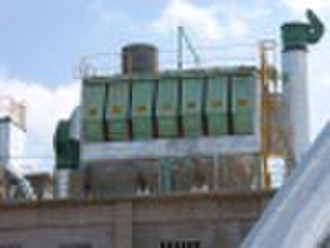粉尘收藏家

leo fan
联系人姓名
基本信息
| 出生地 | Zhejiang China (Mainland) |
|---|---|
| 牌子的名字 | jiexiang |
| 模式的数量 | JLPM(M)7D |
In reverse-pulse-jet baghouses, individual bags are supported by a metal cage, which is fastened onto a cell plate at the top of the baghouse. Dirty gas enters from the bottom of the baghouse and flows from outside to inside the bags. The metal cage prevents collapse of the bag. Bags are cleaned by a short burst of compressed air injected through a common manifold over a row of bags. The compressed air is accelerated by a venturi nozzle mounted at the reverse-jet baghouse top of the bag. Since the duration of the compressed-air burst is short (0.1s), it acts as a rapidly moving air bubble, traveling through the entire length of the bag and causing the bag surfaces to flex. This flexing of the bags breaks the dust cake, and the dislodged dust falls into a storage hopper below. Reverse-pulse-jet dust collectors can be operated continuously and cleaned without interruption of flow because the burst of compressed air is very small compared with the total volume of dusty air through the collector. Because of this continuous-cleaning feature, reverse-jet dust collectors are usually not compartmentalized. The short cleaning cycle of reverse-jet collectors reduces recirculation and redeposit of dust. These collectors provide more complete cleaning and reconditioning of bags than shaker or reverse-air cleaning methods. Also, the continuous-cleaning feature allows them to operate at higher air-to-cloth ratios, so the space requirements are lower. This cleaning system works with the help of digital sequential timer attached to the fabric filter. this timer indicates the solenoid valve to inject the air to the blow pipe. Fabric filters generally have the following parts: Clean plenum Dusty pleanum Bag, cage, ventury assembly Tubeplate RAV/SCREW Compressed air header Blow pipe Housing and hopper
交货条款及包装
端口: Shanghai
付款条款
Letter of credit
Telegraphic transfer
Western Union
-
支付方式
我们接受:









